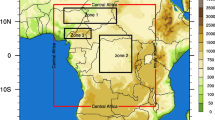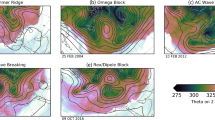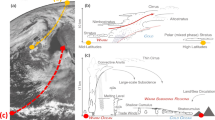Abstract
Three classes of dust over the southwest region of the Kingdom of Saudi Arabia were classified based on both the values and distribution of the TOMS Aerosol Index. These classes include a narrow spread class (i.e., a weak class), a moderate spread class, and a wide spread class (i.e., a strong class). A diagnostic study of these classes indicated that there are common atmospheric features for dust cases, and the intensity of these features increases with the characteristic strength of the dust cases. These features are the horizontal circulation of anticyclonic wind flow associated with lower layer upward motion through the zonal stripe between 17°N and 25°N through the meridional cross-section in addition to a vertical circulation, especially for the layers above 850 hPa. These two circulation patterns merge to form an unstable atmosphere and a deep cyclone. Furthermore, there are areas of convergence and divergence at the points of deepening upward motion and shallow upward motion, respectively. Finally, all these features collectively force the dust from the Arabian Desert to move into the southwest region of the Kingdom of Saudi Arabia.













Similar content being viewed by others
References
Al-Dabbas MA, Abbas MA, Al-Khafaji RM (2010) Dust storms loads analysis—Iraq. Arab J Geosci 5(1):121–131
Al-Dousari A, Al-Awadhi J, Ahmed M (2012) Dust fallout characteristics within global dust storm major trajectories. Arab J Geosci. doi:10.1007/s12517-012-0644-0
Alpert P, Kischa P, Shtivelman A, Krichak SO, Joseph JH (2004) Vertical distribution of Saharan dust based on 2.5 year model predictions. Atmos Res 70:109–130
Awad AM, Mashat AS (2013) Synoptic features associated with dust transition processes from North Africa to Asia. Arab J Geosci. doi:10.1007/s12517-013-0923-4
Barkan J, Kutiel H, Alpert P (2004) Climatology of dust sources over the North African region, based on TOMS data. Indoor Outdoor Environ 13:407–419
Barkan J, Alpert P (2010) Synoptic analysis of a rare event of Saharan dust reaching the Arctic region. Weather 65:208–211
D'Almeida GA (1986) A model for Saharan dust transport. J Clim Appl Meteorol 25(7):903–916
Gates WL (1961) Static stability in the atmosphere. J Meteor 18:526–533
Gautam R, Liu Z, Singh RP, Hsu NC (2009) Two contrasting dust-dominant periods over India observed from MODIS and CALIPSO data. Geophys Res Lett 36:L06813. doi:10.1029/2008GL036967
Hamidi M, Kavianpour MR, Shao Y (2013) Synoptic analysis of dust storms in the Middle East. Asia Pac J Atmos Sci 49:279–86
Herman JR, Bhartia PK, Torres O, Hsu C, Seftor C, Celarier E (1997) Global distribution of UV-absorbing aerosols from Nimbus-7/TOMS data. J Geophys Res 102:16,911–16,922
Hsu NC, Herman JR, Torres O, Holben BN, Tanre D, Eck TF, Simrnov A, Chatenet B, Lavenu F (1999) Comparisons of the TOMS aerosol index with Sunphotometer aerosol optical thickness: results and applications. J Geophys Res 104:6269–6279
Kalendarski S, Stenchikov G, Zhao C (2013) Modeling a typical winter-time dust event over the Arabian Peninsula and the Red Sea. Atmos Chem Phys 13:1999–2014. doi:10.5194/acp-13-1999-2013
Kalnay E, Kanamitsu M, Kistler R, Collins W, Deaven D, Gandin L, IridellM SS, White G, Woollen J, Zhu Y, Chelliah M, Ebisuzaki W, Higgins W, Janowiak J, Mo KC, Ropolewski C, Wang J, Leetma A, Reynolds R, Jenne R, Joseph D (1996) The NCEP/NCAR 40-year Reanalysis project. Bull Am Meteorol Soc 77:437–471
Karyampudi VM, Palm SP, Reagen JA, Hui F, Grant WB, Hoff RM, Mouline HR, Pierce HF, Torres O, Browell ED, Melfi SH (1999) Validation of the Saharan dust plume conceptual model using lidar, Meteosat, and ECMWF data. Bull Am Meteorol Soc 80:1045–1075
Kaskaoutis DG, Kalapureddy MCR, Krishna Moorthy K, Devara PCS, Nastos PT, Kosmopoulos PG, Kambezidis HD (2010) Heterogeneity in pre-monsoon aerosol types over the Arabian Sea deduced from shipboard measurements of spectral AODs. Atmos Chem Phys 10:4893–4908
Kim YK, Song SK, Lee HW, Kim CH, Oh IB, Moon YS, Shon ZH (2006) Characteristics of Asian dust transport based on synoptic meteorological analysis over Korea. J Air Waste Manage 56:306–316
Kim D, Chin M, Yu H, Eck TF, Sinyuk A, Smirnov A, Holben BN (2011) Dust optical properties over North Africa and Arabian Peninsula derived from the AERONET dataset. Atmos Chem Phys Discuss 11:20181–20201
Kishcha P, Alpert P, Barkan J, Kirchner I, Machenhauer B (2003) Atmospheric response to Saharan dust deduced from ECMWF reanalysis (ERA) temperature increments. Tellus B 55:901–913
Kistler R, Collins W, Saha S, White G, Woollen J, Kalnay E, Chelliah M, Ebisuzaki W, Kanamitsu M, Kousky V, vanden Dool H, Jenne R, Fiorino M (2001) The NCEP/NCAR 50-year Reanalyses: monthly CD-ROM and documentation. Bull Am Meteorol Soc 82:247–267
Kutiel H, Furman H (2003) Dust storms in the Middle East: sources of origin and their temporal characteristics. Indoor Built Environ 12:419–426
Maghrabi A, Alharbi B, Tapper N (2011) Impact of the March 2009 dust event in Saudi Arabia on aerosol optical properties, meteorological parameters, sky temperature and emissivity. Atmos Environ 45:2164–2173
Mahowald NM, Luo C, Del Corra IJ, Zender C (2003) Interannual variability in atmospheric mineral aerosols from a 22-year model simulation and observation data. J Geophys Res 108:D12. doi:10.1029/2002 JD002821
Mohalfi S, Bedi HS, Krishnamurti TN, Cocke SD (1998) Impact of shortwave effects on the summer season heat low over Saudi Arabia. Mon Weather Rev 126:3153–3168
Mashat A, Awad AM (2010) The classification of the dusty areas over the Middle-East. Bull Fac Sci Cairo Univ 78:1–19
Middleton NJ (1986) Dust storms in the Middle East. J Arid Environ 10:83–96
Notaro M, Alkolibi F, Fadda E, Bakhrjy F (2013) Trajectory analysis of Saudi Arabian dust storms. J Geophys Res Atmos 118:6028–6043. doi:10.1002/jgrd.50346
Prasad AK, Yang KHS, El-Askary HM, Kafatos M (2009) Melting of major glaciers in the western Himalayas: evidence of climatic changes from long term MSU derived tropospheric temperature trend (1979–2008). Ann Geophys 27:4505–4519
Prospero JM, Ginoux P, Torres O, Nicholson SE, Gill TE (2002) Environmental characterization of global sources of atmospheric soil dust identified with the Nimbus 7 total ozone mapping spectrometer absorbing aerosol product. Reviews of Geophys 40:2–31
Satheesh SK, Vinoj V, Moorthy KK (2010) Assessment of aerosol radiative impact over oceanic regions adjacent to Indian subcontinent using Multisatellite analysis. Adv in Meteorol ID 139186, doi:10.1155/2010/139186
Smirnov A, Holben BN, Dubovic O, O’Neill NT, Eck TF, Westphal DL, Goroth AK, Pietras C, Slutsker I (2002) Atmospheric aerosol optical properties in the Persian Gulf. J Atmos Sci 59:620–634
Tanaka TY, Kurosaki Y, Chiba M, Matsumura T, Nagai T, Yamazaki A, Uchiyama A, Tsunematsu N, Kai K (2005) Possible transcontinental dust transport from North Africa and the Middle East to East Asia. Atmos Environ 39(21):3901–3909
Torres O, Bhartia PK, Herman JR, Ahmad Z, Gleason K (1998) Derivation of aerosol properties from satellite measurements of backscattered ultraviolet radiation: theoretical basis. J Geophys Res 103:17099–17110
Yu Y, Notaro M, Liu Z, Kalashnikova O, Alkolibi F, Fadda E, Bakhrjy F (2013) Assessing temporal and spatial variations in atmospheric dust over Saudi Arabia through satellite, radiometric, and station data. J Geophys Res 118:1–12. doi:10.1002/2013JD020677
Acknowledgments
The authors thank the two anonymous reviewers for their constructive suggestions that improve the paper significantly. The authors also acknowledge the Presidency of Meteorology and Environment of Saudi Arabia for providing surface observation data, and NASA for providing the TOMS data through its website.
Author information
Authors and Affiliations
Corresponding author
Rights and permissions
About this article
Cite this article
Awad, A.M., Mashat, AW.S. & Salem, F.F.A. Diagnostic study of spring dusty days over the southwest region of the Kingdom of Saudi Arabia. Arab J Geosci 8, 2265–2282 (2015). https://doi.org/10.1007/s12517-014-1318-x
Received:
Accepted:
Published:
Issue Date:
DOI: https://doi.org/10.1007/s12517-014-1318-x




